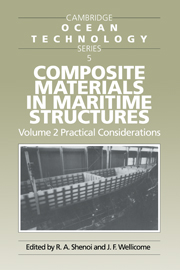Book contents
- Frontmatter
- Contents
- Preface
- List of Authors
- 1 Introduction
- 2 Design of Displacement Craft
- 3 Design of Dynamically Supported Craft
- 4 The Role of Adhesives
- 5 Practical Design of Joints and Attachments
- 6 Production of Ships with Single Skin Structures
- 7 Production of Yacht Hulls of Sandwich Configuration
- 8 Material Case Study - Failures and their Repairs
- 9 Response of Sandwich Structures to Slamming and Impact Loads
- 10 Fatigue Characteristics
- 11 Composites in Offshore Structures
- 12 Regulatory Aspects in Design
- 13 Quality and Safety Assessment
- 14 Design Management and Organisation
- Appendix
- Index
11 - Composites in Offshore Structures
Published online by Cambridge University Press: 04 August 2010
- Frontmatter
- Contents
- Preface
- List of Authors
- 1 Introduction
- 2 Design of Displacement Craft
- 3 Design of Dynamically Supported Craft
- 4 The Role of Adhesives
- 5 Practical Design of Joints and Attachments
- 6 Production of Ships with Single Skin Structures
- 7 Production of Yacht Hulls of Sandwich Configuration
- 8 Material Case Study - Failures and their Repairs
- 9 Response of Sandwich Structures to Slamming and Impact Loads
- 10 Fatigue Characteristics
- 11 Composites in Offshore Structures
- 12 Regulatory Aspects in Design
- 13 Quality and Safety Assessment
- 14 Design Management and Organisation
- Appendix
- Index
Summary
BACKGROUND
Composites offer the possibility of significant savings, in platform topside weight, as well as in installation and through-life maintenance costs when used offshore. FRP has been used to a limited extent in a range of applications on offshore platforms and, despite some of the problems mentioned below, there is now increasing interest in its wider use.
Use of composites in load-bearing elements, both offshore and in other structural applications, is being hindered to a certain extent by a lack of design codes. Recently, a number of joint industry projects have been initiated in an attempt to rectify the situation and the recommendations of these will become available in due course.
One particular obstacle to the use of composites has been their perceived flammability. Several testing programmes have been carried out to quantify fire performance and it has been found that, although the resin phase is indeed potentially combustible, the composite itself often shows interesting and potentially useful effects in fire. The most significant of these effects is the slow rate of burn-through and heat transmission that can be achieved under certain conditions. This property is already being exploited in some piping and panel applications.
There are some limitations connected with the fabrication technology needed to make large structures in composites. The scale of many components in use offshore is larger than in other engineering fields and, unlike the fabrication technology for metals, forming processes for composites are not yet so adaptable to large scale construction.
- Type
- Chapter
- Information
- Composite Materials in Maritime Structures , pp. 199 - 228Publisher: Cambridge University PressPrint publication year: 1993
- 4
- Cited by

